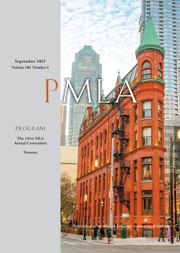No CrossRef data available.
Article contents
Benjamin’s Fire Tongs
Published online by Cambridge University Press: 01 September 2025
Abstract
An abstract is not available for this content so a preview has been provided. Please use the Get access link above for information on how to access this content.
Information
- Type
- Theories and Methodologies
- Information
- Copyright
- © 2025 The Author(s). Published by Cambridge University Press on behalf of Modern Language Association of America
References
Works Cited
Althusser, Louis. Reading Capital. Translated by Ben Brewster and David Fernbach, Verso, 2015.Google Scholar
Benjamin, Walter. The Arcades Project. Translated by H. Eiland and K. McLaughlin, Press, Belknap, 1999.Google Scholar
Benjamin, Walter. Sur le concept d’histoire: Œuvres et inédits. Edited by Raulet, Gérard, Klincksieck, 2023.Google Scholar
Derrida, Jacques. “Force of Law: The ‘Mystical Foundation of Authority.’” Translated by Mary Quaintance. Deconstruction and the Possibility of Justice, edited by Cornell, Druscilla et al., Routledge, 1992, pp. 3–67.Google Scholar
Edmonds, David. The Murder of Professor Schlick: The Rise and Fall of the Vienna Circle. Princeton UP, 2020.Google Scholar
Eisenstein, Sergei. “The Capital Diaries: A New Selection.” October, no. 188, 2024, pp. 25–104.CrossRefGoogle Scholar
Fanon, Frantz. Écrits sur l’aliénation et la liberté. Edited by Khalfa, Jean and Robert, J. C. Young, Découverte, La, 2015.Google Scholar
Fanon, Frantz. The Plays from Alienation and Freedom. Edited by Jean Khalfa and Robert J. C. Young, translated by Steven Corcoran, Bloomsbury, 2020.Google Scholar
Gödel, Kurt. “Diskussion zur Grundlegung der Mathematik am Sonntag, dem 7. Sept. 1930.” Erkenntnis, no. 2, 1931, pp. 135–51.CrossRefGoogle Scholar
Hill, Samantha Rose. “Walter Benjamin’s Last Work.” Los Angeles Review of Books, 9 Dec. 2019, lareviewofbooks.org/article/walter-benjamins-last-work/.Google Scholar
Löwy, Michael. Fire Alarm: Reading Walter Benjamin’s “On the Concept of History.” Translated by Turner, Chris, Verso, 2005.Google Scholar
Marx, Karl, and Engels, Friedrich. Manifesto of the Communist Party. Translated by Moore, Samuel, Publishers, Progress, 1952.Google Scholar
Ngai, Sianne. “Inhabiting Error: From ‘Last Christmas’ to ‘Senior’s Last Hour.’” 17 Nov. 2023, New York U.Google Scholar
Vogman, Elena. “Eisenstein’s Capital Diaries: An Introduction.” October, no. 188, 2024, pp. 3–24.CrossRefGoogle Scholar
White, Jonathan. In the Long Run: The Future as a Political Idea. Profile Books, 2024.Google Scholar
Young, Robert J. C. “Re-reading the Symptomatic Reading.” The Concept in Crisis: Reading Capital Today, edited by Nick Nesbitt, Duke UP, 2017, pp. 35–48.CrossRefGoogle Scholar
Young, Robert J. C.. “Winging It with Wittgenstein and Benjamin.” NeoHelicon, no. 51, 2024, pp. 33–56.CrossRefGoogle Scholar

